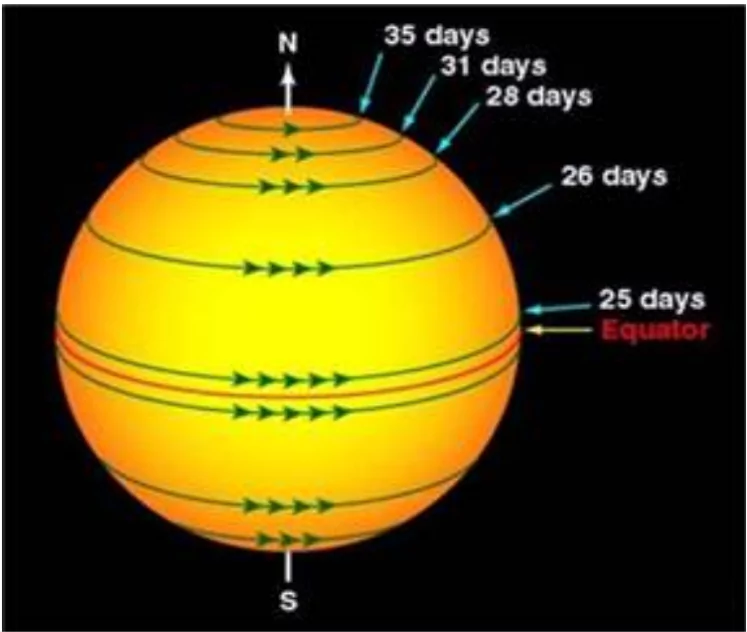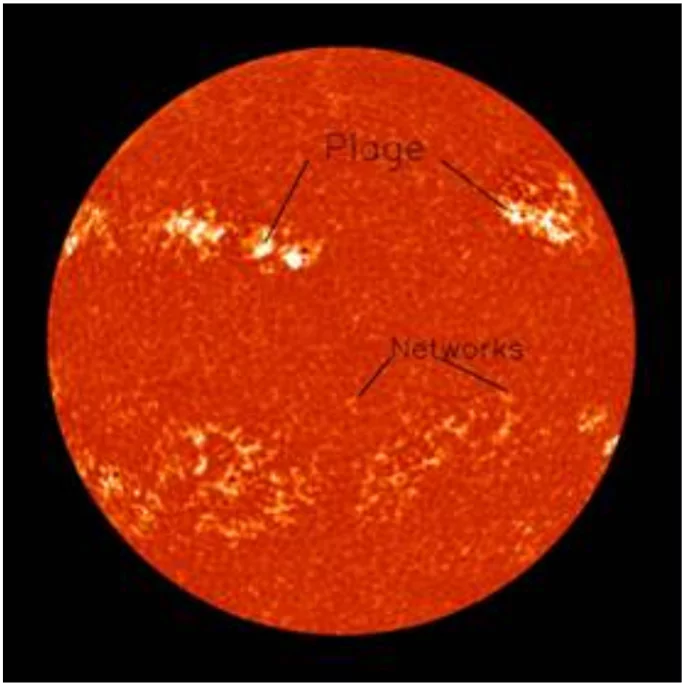Astronomers at the Kodaikanal Solar Observatory have mapped variation in the rotation speed of the Sun’s chromosphere, from the equator right up to its polar regions for the first time using 100 years of daily records of the Sun.
Key Findings from the Mapping of Sun’s Chromosphere
Chromosphere: The chromosphere is a thin layer of plasma that lies between the Sun’s visible surface (the photosphere) and the corona (the Sun’s upper atmosphere).
- It extends for at least 2,000 km (1,200 mi.) above the surface.
- It appears bright red because the hydrogen in the Sun emits a reddish-coloured light at high temperatures.
|
- Differential Rotation Rates: The Sun rotates faster at the equator (13.98 degrees per day) and slower towards the poles (10.5 degrees per day at 80 degrees latitude).
- Similar Rotation of Features: Plages and network features exhibit similar rotation rates, suggesting a shared origin deep within the Sun.
- First Mapping Achievement: This study is the first to successfully use chromospheric network cells to map the Sun’s rotation from the equator to the poles.
Enroll now for UPSC Online Classes
About Differential Rotation

- Definition: The difference in rotation speed between the Sun’s equator and poles is known as differential rotation.
- Earth vs. Sun’s Rotation
- Earth’s Uniform Rotation: Earth rotates as a rigid body, completing a full rotation every 24 hours, with uniform rotation speed from equator to poles.
- Sun’s Differential Rotation: The Sun, made of plasma, rotates at different speeds based on latitude.
- The Sun’s equator spins much faster than its poles.
- It takes the equatorial region only about 25 days to complete one rotation, while the poles take a leisurely 35 days. (Diagram represents the Sun’s differential rotation, where surface regions at various latitudes rotate at different speeds.)
- Significance of Differential Rotation
- Understanding the intricacies of the variation in rotation speed, as a function of latitude as well as time, is crucial to understand the Sun itself.
- It drives the solar dynamo, the 11-year solar cycle, and periods of intense solar activity that can trigger magnetic storms on Earth.
Kodaikanal Solar Observatory (KoSO)
- Established: In 1899,
- Operated by: The Government of India separated Astrophysics from the India Meteorological Department (IMD) in April 1971.
- The KoSO was brought under the Indian Institute of Astrophysics (IIA), Bengaluru on April 1, 1971.
- Location: Situated at the southern tip of the Palani Hills in Tamil Nadu, known for its clear skies, low humidity, and minimal fog.
- Key Scientific Discovery: The Evershed effect, the apparent radial flow of gas in the penumbra of sunspots, was first observed here in January 1909.
- In News: The Observatory is celebrating its 125th anniversary, and is just one of two such places in the entire world with such long-term data
- Advanced Instruments at KoSO
- H-alpha Telescope: Used for full-disc imaging of the Sun.
- White Light Active Region Monitor (WARM): Equipped with calcium and sodium filters for simultaneous observations of the photosphere and chromosphere.
|
-
-
- Discovery of Differential Rotation: The discovery of differential rotation dates back to Carrington in the 19th century, who observed that sunspots on the visible surface of the Sun rotate at different speeds depending on their latitude.
- Challenges of Relying on Sunspot Observations for Differential Rotation:
- Limited Latitude Coverage: Sunspots do not appear above 35 degrees latitude, restricting their use in measuring the Sun’s rotation closer to the poles.
- Infrequency at High Latitudes: Sunspots occur rarely at higher latitudes, making data collection sparse and unreliable for studying the Sun’s full rotational dynamics. This necessitated alternative methods
- Inadequate for Time-Dependent Studies: Sunspot-based methods are insufficient for tracking how differential rotation varies over time, such as across the solar cycle, due to limited and sporadic data.
Check Out UPSC NCERT Textbooks From PW Store
Innovative Approach by Indian Institute of Astrophysics (IIA)
- Use of Solar Plages and Networks: Astronomers from the Indian Institute of Astrophysics (IIA) utilised solar plages and networks from 100 years of daily Sun records maintained by the Kodaikanal Solar Observatory, to study its rotation.
 About Solar Plages: Brighter regions in the chromosphere with weaker magnetic fields than sunspots.
About Solar Plages: Brighter regions in the chromosphere with weaker magnetic fields than sunspots.
- Significantly larger than sunspots, ranging from 3 to 10 times their size.
- About Networks: Embedded in weak magnetic fields and are about 30,000 km across.
- Slightly larger than individual sunspots, but smaller than sunspot groups.
- Significance of using Plages and Networks:
- Unlike sunspots, plages and network features are present across the Sun’s surface throughout the solar cycle.
- This consistent presence enables astronomers to study the Sun’s rotation, even in polar regions, where sunspots are scarce.
![]() 30 Sep 2024
30 Sep 2024

 About Solar Plages: Brighter regions in the chromosphere with weaker magnetic fields than sunspots.
About Solar Plages: Brighter regions in the chromosphere with weaker magnetic fields than sunspots.
